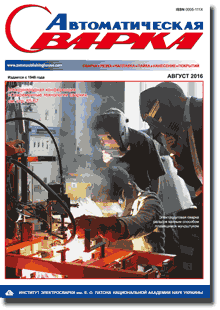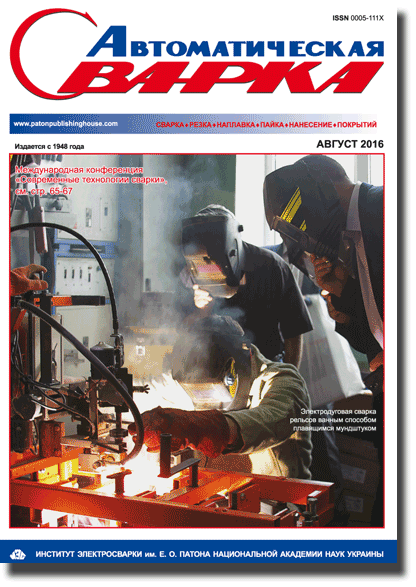| 2016 №08 (03) |
DOI of Article 10.15407/as2016.08.04 |
2016 №08 (05) |

Avtomaticheskaya Svarka (Automatic Welding), #8, 2016, pp. 21-28
Formation of weld metal structure in electron beam welding of single crystals of high-temperature nickel alloys
K.A. Yushchenko1, B.A. Zadery1, I.S. Gakh1 and O.P. Karasevskaya2
1E.O. Paton Electric Welding Institute, NASU, 11 Kazimir Malevich Str., 03680, Kiev, Ukraine. E-mail: office@paton.kiev.ua
2G.V. Kurdyumov Institute for Metal Physics, NASU, 35 Acad. Vernadsky Ave., 03680, Kiev, Ukraine. E-mail: Karas@imp.kiev.ua
Abstract
Investigations of the features of temperature-rate parameters of weld pool metal solidification in EBW of single crystals of high-temperature nickel alloys were the basis for establishing the peculiarities of their influence on ensuring the single-crystal structure. Investigations were performed on single-crystal samples of commercial high-temperature nickel alloy JS26 with application of methods of thermometry of liquid pool melt during weld metal solidification at cooling. The structures were studied with application of methods of microprobe analysis, optical and electron metallography and XRD. A computational-experimental procedure for determination of temperature-rate parameters of weld metal solidification is proposed, the nature of their variation across weld pool solidification front is shown, and the interrelation with the welding modes is established. The range of parameter values was determined, in which grains with random crystallographic orientation form in the weld. The possibility of controlling the structural perfection of weld metal through optimization of temperature-rate parameters of solidification is shown. 23 Ref., 4 Tables, 10 Figures.
Keywords: ingle crystal, high-temperature nickel alloy, temperature-rate conditions, temperature gradient, crystallographic orientation, weld, orientation of predominant crystal growth, direction of maximum temperature gradient, randomly oriented grains
Received: 17.05.16
Published: 03.10.16
References
- (1995) Superalloys II: Heat-resistant materials for aerospace systems and industrial power plants. Book 1. Moscow: Metallurgiya.
- Erickson, G.L., Harris, K. (1994) DS and SX superalloys for industrial gas turbines. In: of Conf. on Materials for Advanced Power Engineering (Belgium, 3–6 Oct. 1994), Pt 2, 1055–1074. Kluwer Acad. Publ.
- Erickson, G.L. (1995) A new third generation single crystal, casting superalloy. of Metals, 47(4), 36–39. https://doi.org/10.1007/bf03221147
- (2006) Cast heat-resistant alloys. T. Kishkin effect: Sci.-techn. coll. Moscow: Nauka.
- Shalin, R.E., Svetlov, I.L., Kachanov, E.B. et al. (1997) Single crystals of nickel heat-resistant alloys. Moscow: Mashinostroen
- Stroganov, G.B., Chepkin, V.M. (2000) Cast heat-resistant alloys for gas turbines, 63–65. Moscow: ONTI MATI.
- Shah, D.M., Duhl, D.N. (1984) Effect of orientation, temperature and gamma prime size on the yield strength of a single crystal nickel base superalloy. In: Superalloys, 105–114. Metallur. Soc. of https://doi.org/10.7449/1984/superalloys_1984_105_114
- Kishkin, S.T., Stroganov, G.B., Logunov, A.V. (2001) Nickel-based cast heat-resistant alloys. Moscow: MISIS.
- Dong, H.B., Yang, X.L., Lee, P.D. (2004) Simulation of equiaxed growth ahead of an advancing columnar front in directionally solidified Ni-base superalloys. Materials Sci., 39, 7207–7212. https://doi.org/10.1023/B:JMSC.0000048733.96958.c3
- Kablov, E.N. (2001) Cast blades of gas-turbine engines (alloys, technology, coatings). Moscow: MISIS.
- Yushchenko, K.A., Gakh, I.S., Zadery, B.A. et al. (2013) Influence of weld pool geometry on structure of metal of welds on high-temperature nickel alloy single crystals. The Paton Welding J., 5, 45–50.
- Yushchenko, K.A., Zadery, B.A., Gakh, I.S. et al. (2013) On nature of grains of random orientation in welds of single crystals of heat-resistant nickel alloys. Metallofizika i Nov. Tekhnologii, 35(10), 1347–1357.
- Yushchenko, K.A., Zadery, B.A., Zvyagintseva, A.V. et al. (2008) Sensitivity to cracking and structural changes in EBW of single crystals of heat-resistant nickel alloys. The Paton Welding J., 2, 6–13.
- Gakh, I.S. (2011) Physical-technological peculiarities of electron beam welding of high-nickel heat-resistant alloys with single-crystal structure: Syn. of Thesis for Cand. of Techn. Sci. Degree. Kiev: PWI.
- Rabkin, D.M., Ignatiev, V.G., Dovbishchenko, I.V. (1982) Arc welding of aluminium and its alloys. Moscow: Mashinostroenie.
- Rykalin, N.N. (1951) Calculations of thermal processes in welding. Moscow: Mashgiz.
- Frolov, V.V., Vinokurov, V.A., Volchenko, V.N. et al. (1988) Theoretical principles of welding. Moscow: Vysshaya Shkola.
- Solomatova, E.S., Trushnikov, D.N., Belenky, V.Ya. et al. (2014) Evaluation of temperature in vapor gas channel in EBW of dissimilar metals. Problemy Nauki i Obrazov., 2, 21–26.
- Panin, V.E., Likhachev, V.A., Grinyaev, Yu.V. (1985) Structural levels of deformation of solids. Novosibirsk: Nauka.
- Likhachev, V.A., Panin, V.E., Zasimchuk, E.E. et al. (1989) Cooperative deformation processes and localization of deformations. Kiev: Naukova Dumka.
- Malygin, G.A. (1995) Self-organizing of dislocations and localization of slipping in plastically deformed crystals. Fizika Tv. Tela, 37(Issue 1), 3–42.
- Sarafanov, G.F. (1998) To theory of formation of heterogeneous dislocation structures. Fizika Metallov i Metallovedenie, 85(Issue 3), 46–53.
- Koneva, N.A., Kozlov, E.V. (1990) Physical nature of staging of plastic deformation. Izvestiya Vuzov, Fizika, 2, 89–106.
The cost of subscription/purchase order journals or individual articles
| Journal/Currency | Annual Set | 1 issue printed |
1 issue |
one article |
| TPWJ/USD | 384 $ | 32 $ | 26 $ | 13 $ |
| TPWJ/EUR | 348 € | 29 € | 24 € | 12 € |
| TPWJ/UAH | 7200 UAH | 600 UAH | 600 UAH | 280 UAH |
| AS/UAH | 1800 UAH | 300 UAH | 300 UAH | 150 UAH |
| AS/USD | 192 $ | 32 $ | 26 $ | 13 $ |
| AS/EUR | 180 € | 30 € | 25 € | 12 € |
| SEM/UAH | 1200 UAH | 300 UAH | 300 UAH | 150 UAH |
| SEM/USD | 128 $ | 32 $ | 26 $ | 13 $ |
| SEM/EUR | 120 € | 30 € | 25 € | 12 € |
| TDNK/UAH | 1200 UAH | 300 UAH | 300 UAH | 150 UAH |
| TDNK/USD | 128 $ | 32 $ | 26 $ | 13 $ |
| TDNK/EUR | 120 € | 30 € | 25 € | 15 € |
AS = «Automatic Welding» - 6 issues per year;
TPWJ = «PATON WELDING JOURNAL» - 12 issues per year;
SEM = «Electrometallurgy Today» - 4 issues per year;
TDNK = «Technical Diagnostics and Non-Destructive Testing» - 4 issues per year.





